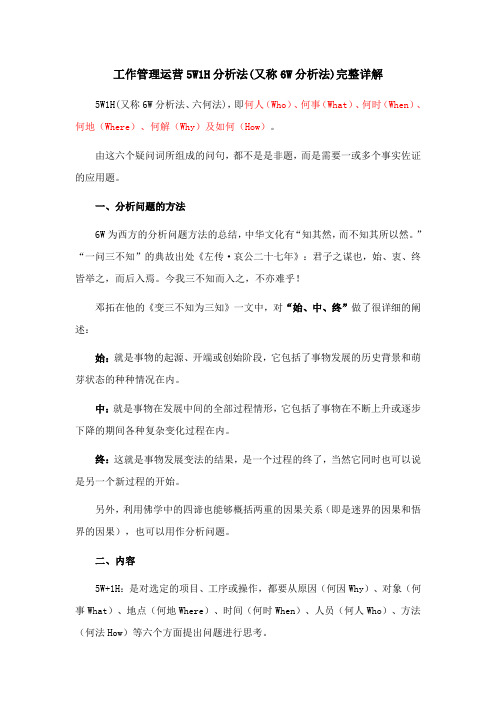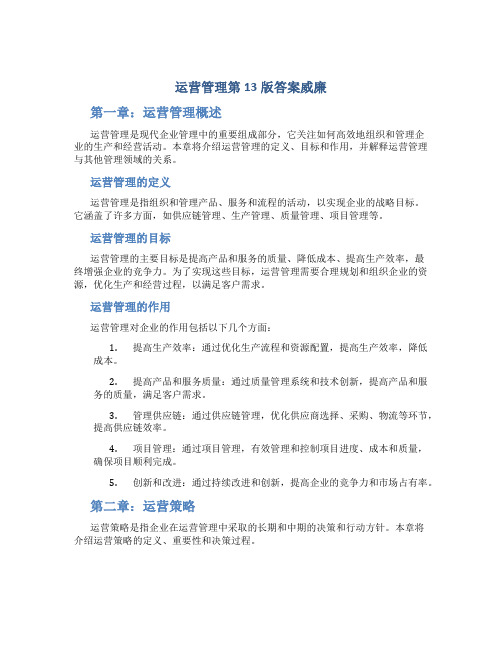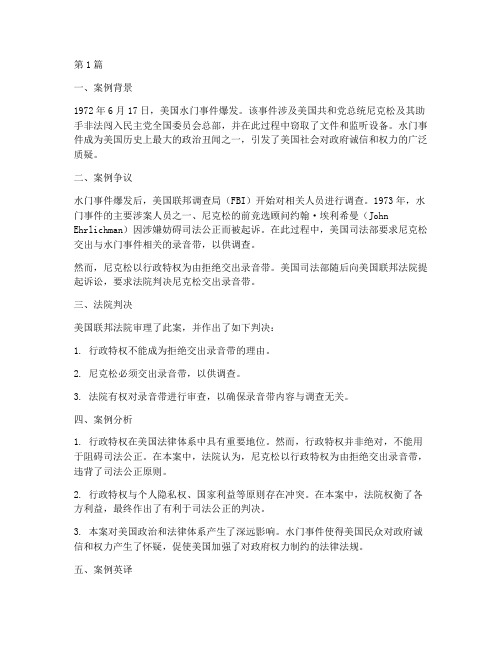H456运营管理-13_Case Analysis(1)
operation analysis工作职责

operation analysis工作职责
Operation analysis的工作职责主要包括以下几个方面:
1. 数据收集和分析:负责收集和整理相关业务运营的数据,进行数据分析,并根据分析结果提出改进意见和建议。
这包括通过调查、观察和访谈等方法收集数据,使用统计和数据分析工具进行数据分析,挖掘数据中的关键信息。
2. 运营效率评估:分析现有运营流程和流程中的问题,识别潜在的瓶颈和改进机会。
通过流程重组、优化和自动化来提高运营效率。
对运营指标进行监测和评估,以确保运营活动的顺利进行。
3. 项目管理和执行:参与运营项目的策划、管理和执行。
制定项目计划、项目进度和团队任务分配,确保项目按时按量完成。
与团队成员和相关方面进行沟通和协调,解决项目执行中的问题和挑战。
4. 风险管理:识别和评估潜在的运营风险,并制定风险管理计划。
跟踪和监测风险的发展和变化,及时采取措施来缓解和管理风险。
5. 数据报告和可视化:根据分析结果和运营需求,制作数据报告和可视化工具,以便向管理层和相关方提供有关运营状况和趋势的信息。
确保报告和可视化工具的准确性和易读性。
6. 运营策略建议:基于对运营数据和环境的分析,提供运营策
略和改进建议。
这包括对市场趋势、竞争对手和客户需求的分析,以制定适合的运营策略和行动计划。
总的来说,operation analysis的工作职责是通过对业务运营数据的收集、分析和评估,推动运营活动的改进和优化,提高运营效率和业务绩效。
5w1h分析法案例

5w1h分析法案例在日常生活中,我们经常会遇到各种问题和情况,而要解决这些问题,我们就需要使用5w1h分析法。
这种分析方法可以帮助我们全面、系统地了解问题的各个方面,从而更好地解决问题。
下面,我将通过一个实际案例来介绍5w1h分析法的运用。
案例,公司销售额下降。
What(什么),公司销售额下降。
Why(为什么),市场竞争激烈,产品陈旧,销售团队士气低落。
Where(在哪里),全国范围内。
When(何时),最近一年。
Who(谁),销售团队、市场部门、产品部门、高层管理人员。
How(如何),重新制定营销策略,更新产品线,激励销售团队。
What(什么),公司销售额下降。
公司销售额下降是一个明显的问题,这直接影响到公司的经营状况和发展前景。
因此,需要对这个问题进行深入分析,找出问题的根源,从而采取有效的措施来解决。
Why(为什么),市场竞争激烈,产品陈旧,销售团队士气低落。
销售额下降的原因可能有很多,比如市场竞争激烈导致市场份额下降,产品陈旧导致消费者对产品失去兴趣,销售团队士气低落导致销售业绩下滑等。
这些都是导致销售额下降的可能原因,需要逐一进行分析和解决。
Where(在哪里),全国范围内。
公司销售额下降的影响范围是全国范围内,这意味着问题的解决需要考虑到全国各地的市场情况和销售团队情况,需要制定相应的全国性解决方案。
When(何时),最近一年。
销售额下降的时间跨度是最近一年,这说明问题并非一时之间所致,而是经过一段时间的积累和发展而导致的。
因此,解决问题也需要一定的时间和步骤。
Who(谁),销售团队、市场部门、产品部门、高层管理人员。
解决销售额下降的问题需要各个部门的共同努力,包括销售团队、市场部门、产品部门以及高层管理人员。
每个部门都有自己的责任和任务,需要共同协作来解决问题。
How(如何),重新制定营销策略,更新产品线,激励销售团队。
针对销售额下降的问题,可以通过重新制定营销策略来重新树立品牌形象,更新产品线来满足市场需求,激励销售团队来提高销售业绩。
运营管理CRU案例分析课件

•9
•1
CRU现状
• 运营状况
• 96年,设备每周出租1000台,平均租期8周,每周 每台设备平均收益30美金。
• 97年,采取了一些列激励措施和促销后,每周出 租1400台,600台----平均租期8周,每台每周平均 获益30美金,800台—平均租期4周,每台每周平
均收益35美金。
•运营管理CRU案例分析
• 缓冲时间的维修成本一定的条件下,采购设备的成本一定 的条件下,最大收益或利润取决于:
• 不在缓冲时间的设备数量,就是能够出租的周*状态20的 数量
• 缓冲时间越短,出租周期越长,出租周期越长,租金就越 低,
• 所以要寻求周*状态20的数量*租金的最大值。
•运营管理CRU案例分析
•8
Q&A
•运营管理CRU案例分析
•2
CRU现状
• 绩效评估
1、正常状态20缓冲区依然是维持两周的需求 2、另外购买了一些设备,从1000台到1400台 3、97年的利用率也回到了合理的水平,结果显示, 97年利润下降了。
•运营管理CRU案例分析
•3
案例问题
• 利用率是能显示绩效评估的指标,利用率 增加了,可利润却降低了?
• 提出合适建议的框架
• 1、一般遵循租期越长,租金越低,租期越短,租金越高
• 2、销售需求或市场需求的影响
• 注:紫色暂时设定为不改变的因素
•运营管理CRU案例分析
•6
案例分析
• C RU的收益主要取决于三个指标:
• 1、出租设备数量
• 2、出租周期
• 3、设备平均租金
• 出租设备数量受两个因素影响:
• 1、购买设备的数量
CRU现状
5w1h分析法经典案例

5w1h分析法经典案例5W1H分析法,又称为“六何分析法”,是一种常用的问题分析和解决工具。
它通过回答六个基本问题——Who(谁)、What(什么)、When (何时)、Where(何地)、Why(为什么)和How(怎样),来全面分析问题,从而找出解决问题的方法。
下面,我们将通过一个经典案例来展示5W1H分析法的应用。
案例背景:一家制造型企业近期发现其产品退货率异常升高,这对企业的声誉和财务状况造成了严重影响。
为了解决这一问题,企业决定使用5W1H分析法进行深入分析。
Who(谁):- 受影响的主要群体是消费者,他们在使用产品后发现问题并选择退货。
- 企业内部,生产部门、质量控制部门和客户服务部门是直接相关的部门。
What(什么):- 产品退货率升高,具体表现为某型号产品在一定时间内的退货数量超过了正常水平。
- 退货的主要原因包括产品质量问题、功能不满足消费者需求、包装破损等。
When(何时):- 退货率的异常升高开始于三个月前,此后一直呈上升趋势。
- 退货高峰通常出现在产品发布后的一个月内。
Where(何地):- 退货主要集中在几个主要的销售区域,包括东部沿海城市和中部地区。
- 企业的生产工厂位于西部,而质量控制中心则位于东部。
Why(为什么):- 产品质量问题可能是由于生产过程中的疏忽或原材料质量不稳定。
- 功能不满足消费者需求可能是因为产品设计没有充分考虑市场趋势和消费者偏好。
- 包装破损可能是因为物流过程中的不当处理。
How(怎样):- 为了解决产品质量问题,企业需要加强生产过程中的质量控制,并定期检查原材料供应商的质量标准。
- 针对功能不满足消费者需求的问题,企业应该进行市场调研,了解消费者的真实需求,并据此调整产品设计。
- 为了减少包装破损,企业需要与物流公司合作,优化包装材料和运输方式。
通过5W1H分析法,企业能够全面地理解退货率升高的问题,并针对每个问题点制定相应的解决策略。
这种方法不仅帮助企业找到了问题的根源,还为问题的解决提供了清晰的方向。
5w1h分析法案例

5w1h分析法案例5W1H分析法案例。
5W1H分析法是一种常用的问题分析方法,通过对问题进行“what(什么)”、“why(为什么)”、“where(在哪里)”、“when(何时)”、“who(谁)”和“how(如何)”等六个方面的全面分析,可以帮助我们更好地理解问题的本质和解决问题的方法。
下面,我们通过一个实际案例来介绍5W1H分析法的具体运用。
案例,某公司产品销量下滑的原因分析。
What(什么),公司某款产品的销量出现了明显的下滑。
这款产品是公司的明星产品之一,曾经一度占据市场的主导地位。
然而,最近几个月来,产品的销量却持续下滑,给公司带来了一定的压力。
Why(为什么),产品销量下滑的原因可能有多方面的因素。
首先,市场竞争加剧,同类产品层出不穷,消费者的选择面越来越广。
其次,产品质量问题可能也是导致销量下滑的原因之一。
消费者对产品的品质要求越来越高,如果产品的质量无法满足消费者的需求,就会失去市场竞争力。
另外,市场营销策略、渠道管理、售后服务等方面的问题也可能对产品销量造成影响。
Where(在哪里),产品销量下滑的影响主要集中在公司的主要销售区域。
通过对销售数据的分析发现,产品销量下滑的主要集中在一些重点城市和地区,而在其他一些地区销量仍然保持着稳定的增长。
When(何时),产品销量下滑的时间节点是在最近几个月内。
通过对销售数据的比对分析,可以清楚地看到销量下滑的趋势,而且这一趋势并没有出现反转的迹象。
Who(谁),产品销量下滑的问题需要公司的销售团队、市场部门、产品研发团队等相关部门共同分析和解决。
销售团队需要深入了解市场的需求和竞争情况,市场部门需要重新评估市场营销策略的有效性,产品研发团队需要对产品的质量进行再次评估和改进。
How(如何),针对产品销量下滑的问题,公司需要采取一系列的措施来解决。
首先,需要对产品的质量进行全面的检查和改进,确保产品能够满足消费者的需求。
其次,需要重新评估市场营销策略,制定更加精准的市场推广计划,提高产品的知名度和美誉度。
5W1H分析法

04
When
选择合适的促销时机和持续时间,考 虑节假日、季节等因素。
06
How
制定具体的促销执行计划和预算安排,包括人 员、物资、宣传等方面的准备和实施。
品牌传播与形象塑造
Why
明确品牌传播的目的和意义 ,以及要解决的市场问题。
What
设计具有独特性和识别度的 品牌形象和标识系统。
Who
确定品牌传播的目标受众和影响群体。
What
确定项目的范围、需求和可交付 成果。
Who
识别项目干系人,明确各自的职 责和角色。
How
选择适合项目的管理方法和工具 。
Where
确定项目的地理位置和资源需求 。
When
制定项目的时间表和里程碑计划 。
项目计划阶段
Why
分析项目计划的必要性和 重要性。
Who
明确各项任务的负责人和 协作团队。
THANK YOU
渠道选择与拓展
Why
明确渠道选择的目的和意义,以及要解决的市场问题。
What
分析不同渠道的特点和优势,选择适合产品的销售渠道 。
Who
确定渠道合作伙伴和经销商,建立良好的合作关系。
When
根据市场变化和消费者需求变化,及时调整渠道策略。
Where
确定渠道的覆盖范围和拓展方向,包括线上和线下渠道 。
5W1H分析法
• 引言 • 5W1H分析法核心问题 • 5W1H分析法在项目管理中应用 • 5W1H分析法在市场营销中应用 • 5W1H分析法在团队协作中应用 • 总结与展望
01
引言
目的和背景
目的
明确问题,找出解决方案,有效 管理和改进工作流程。
5w1h分析法案例

5w1h分析法案例在项目管理和问题解决领域,5W1H分析法是一种常用的方法,它通过回答六个关键问题来帮助我们全面理解问题或项目。
这六个问题分别是:Who(谁)、What(什么)、When(何时)、Where(在哪里)、Why(为什么)和How(如何)。
下面是一个使用5W1H分析法的案例。
案例背景:一家科技公司计划推出一款新的智能手机应用,旨在提高用户的日常生活效率。
1. Who(谁)- 项目团队:由项目经理、产品经理、UI/UX设计师、开发人员、测试人员和市场营销专家组成。
- 目标用户:忙碌的都市白领,他们需要一个能够整合日程、提醒和任务管理的应用。
2. What(什么)- 产品:一款名为“效率助手”的智能手机应用,它能够同步用户的日历、提醒事项,并提供任务管理功能。
3. When(何时)- 项目启动:2024年1月。
- 初步设计完成:2024年3月。
- 开发阶段:2024年4月至7月。
- 内部测试:2024年8月。
- 公测:2024年9月。
- 正式发布:2024年10月。
4. Where(在哪里)- 项目团队位于公司的总部,位于市中心的科技园区。
- 应用将在全球范围内的iOS和Android平台上发布。
5. Why(为什么)- 市场需求:市场上缺乏一个能够满足快节奏生活需求的集成应用。
- 竞争优势:通过提供独特的功能和用户体验,该应用有望在竞争激烈的市场中脱颖而出。
6. How(如何)- 项目管理:采用敏捷开发方法,确保项目进度和质量。
- 设计和开发:使用最新的编程语言和框架,确保应用的性能和兼容性。
- 测试:进行全面的单元测试、集成测试和用户测试,以确保应用的稳定性和用户体验。
- 营销推广:通过社交媒体、广告和合作伙伴关系来提高应用的知名度。
通过以上分析,项目团队能够清晰地理解项目的各个方面,并制定出相应的计划和策略。
5W1H分析法帮助团队确保在项目实施过程中考虑到所有关键因素,从而提高项目成功的可能性。
运营管理第13版威廉答案

运营管理第13版威廉答案简介《运营管理第13版威廉答案》是针对威廉斯(William J. Stevenson)所著的《运营管理第13版》的习题答案。
本文档提供了该教材中各章习题的解答,旨在帮助读者更好地理解运营管理的相关概念和技术,以及提供实践中的解决方案。
目录1.第一章管理运营2.第二章策略运营3.第三章产品开发和服务4.第四章运营设计与管理5.第五章作业设计与管理6.第六章劳动生产力与工资7.第七章质量管理8.第八章项目管理9.第九章供应链管理10.第十章需求管理11.第十一章待定12.第十二章待定第一章管理运营本章主要介绍运营管理的概念和作用,以及管理者在日常运营中所扮演的角色。
主要内容包括: - 运营管理的定义 - 运营管理与企业成功的关系 - 运营管理的目标和职责 - 运营管理者的技能需求 - 运营管理在不同类型组织中的应用第二章策略运营本章探讨了策略运营的重要性以及如何制定和执行有效的运营战略。
重点讨论内容包括: - 运营战略的定义和作用 - 策略运营的步骤和工具 - 运营绩效指标的选择和评估 - 运营风险管理第三章产品开发和服务本章介绍了产品开发和服务管理的基本概念和方法。
重点讨论内容包括: - 产品开发过程和方法 - 产品设计和工艺选择 - 服务设计和交付管理 - 服务质量和客户满意度的评估第四章运营设计与管理本章介绍了运营设计和管理的关键原则和方法。
主要内容包括: - 运营系统设计和优化 - 生产和服务流程管理 - 资源分配和利用策略第五章作业设计与管理本章讨论了作业设计和管理的重要性以及如何提高作业效率和质量。
重点讨论内容包括: - 作业设计原则和方法 - 作业计划和调度 - 作业控制和改进第六章劳动生产力与工资本章探讨了劳动生产力和工资管理的关键问题和方法。
重点讨论内容包括: - 劳动生产力的衡量和提高 - 工资制度和激励机制 - 劳动力管理和培训第七章质量管理本章介绍了质量管理的基本概念和方法。
运营管理-红酸果案例分析报告

第一题高峰时期11:00开工,这时候一共来了1800桶干果子和4200桶湿果子。
但是我们只能存放3200桶湿果子。
并且开工之后,生产线每小时只能够处理600桶湿果子,而送来的湿果子却有1050桶。
这样运行,所有果子处理完需要到次日10:00,最倒霉的车需要等13个小时左右,最多的时候积存了7800桶果子在等待的车上。
第二题题里面的流程图有点不喜欢,下面画一个看着顺眼的。
图2.1这样看起来就舒服多了,X代表去茎叶的电台极其用来处理干果子的比例。
从速率上,我们可以明显看出,烘干机是瓶颈。
根据烘干效率来计算,那么每天处理完所有的果子需要21h再加上2h的收拾屋子时间,还有线上流动的时间,中间的滞留,一天就过去了……第三题烘干机:21h分选机:15h根据图2.1,烘干和分选是瓶颈第四题图4.1如果干、湿比例变成7:3那么就流程图就会变成图4.1的样子,那么只有分选过程是瓶颈。
、第五题早一点开始运行可能会减少储存箱积满导致的货车等待的可能性,在高峰期可一定程度上提早下班时间,从而少付一些员工工资。
但是挺费电的。
10-12月的低古时段,如果3点运行机器的话,晚上10:00才能完成当天的工作。
不太现实。
9月初的低谷时段,如果三点运行的话,下午7:00左右就完成工作了,还挺合理的最佳时间随接收量变化的原因是:运转机器是要付制造费用的,人工+水电其实挺贵的,所以能少开尽量少开。
于是我们根据每天的接收量计算一下生产线多久能够处理完,尽量晚开一会儿,有利于降低成本。
第六题优先考虑完成工作时间来安排生产,穷举了添加烘干机个数和改造储藏箱个数,形成了如下表格。
可以看出,添加一个烘干机比较优,由于分选机的瓶颈作用,添加第二个并不能够带来巨大的改变。
在增加0、1、2个的情况下,改变14、10、6个箱子最优。
第七题根据第一年高峰期的数据,假设湿果比例的方差和产量不变。
希望60%,80%,95%的高峰期能够在19:00,、21:00能够完成工作,货车最多等4h、2h,给出如下12组合理方案。
工作管理运营5W1H分析法(又称6W分析法)完整详解

工作管理运营5W1H分析法(又称6W分析法)完整详解5W1H(又称6W分析法、六何法),即何人(Who)、何事(What)、何时(When)、何地(Where)、何解(Why)及如何(How)。
由这六个疑问词所组成的问句,都不是是非题,而是需要一或多个事实佐证的应用题。
一、分析问题的方法6W为西方的分析问题方法的总结,中华文化有“知其然,而不知其所以然。
”“一问三不知”的典故出处《左传·哀公二十七年》:君子之谋也,始、衷、终皆举之,而后入焉。
今我三不知而入之,不亦难乎!邓拓在他的《变三不知为三知》一文中,对“始、中、终”做了很详细的阐述:始:就是事物的起源、开端或创始阶段,它包括了事物发展的历史背景和萌芽状态的种种情况在内。
中:就是事物在发展中间的全部过程情形,它包括了事物在不断上升或逐步下降的期间各种复杂变化过程在内。
终:这就是事物发展变法的结果,是一个过程的终了,当然它同时也可以说是另一个新过程的开始。
另外,利用佛学中的四谛也能够概括两重的因果关系(即是迷界的因果和悟界的因果),也可以用作分析问题。
二、内容5W+1H:是对选定的项目、工序或操作,都要从原因(何因Why)、对象(何事What)、地点(何地Where)、时间(何时When)、人员(何人Who)、方法(何法How)等六个方面提出问题进行思考。
5W1H分析法思路:1、对象(What)—什么事公司生产什么产品?车间生产什么零配件?为什么要生产这个产品?能不能生产别的?我到底应该生产什么?例如:如果这个产品不挣钱,换个利润高点的好不好?2、场所(Where)—什么地点生产是在哪里干的?为什么偏偏要在这个地方干?换个地方行不行?到底应该在什么地方干?这是选择工作场所应该考虑的。
3、时间和程序(When)—什么时候例如这个工序或者零部件是在什么时候干的?为什么要在这个时候干?能不能在其他时候干?把后工序提到前面行不行?到底应该在什么时间干?4、人员(Who)—责任人这个事情是谁在干?为什么要让他干?如果他既不负责任,脾气又很大,是不是可以换个人?有时候换一个人,整个生产就有起色了。
operation management 书

一、介绍1.1 Operation Management 的定义 1.2 Operation Management 的重要性 1.3 这本书的主题和内容简介二、 Operation Management 的理论基础2.1 大生产原理2.2 优化理论2.3 运作管理模型三、 Operation Management 的关键概念3.1 生产计划和控制3.2 添加值3.3 质量管理3.4 供应链管理四、 Operation Management 的实践应用4.1 生产流程优化4.2 资源配置4.3 成本控制4.4 在全球化环境中的运作管理五、 Operation Management 的案例研究5.1 著名企业的运作管理案例5.2 成功的运作管理实践经验共享5.3 失败的案例分析和教训六、 Operation Management 的挑战与未来发展6.1 技术变革对运作管理的影响6.2 全球化挑战6.3 环境可持续性与运作管理6.4 数据驱动的运作管理七、结语7.1 总结7.2 对未来运作管理的展望---Operation Management 是企业管理中非常重要的一环。
它涵盖了企业生产计划和控制、优化流程、成本控制、质量管理、供应链管理等方面。
通过合理的运作管理,企业可以提高效益,加强竞争力,取得长期发展。
理论基础部分主要介绍了大生产原理、优化理论和运作管理模型。
这些理论为企业提供了运作管理的思想基础和方法论。
Operation Management 的关键概念包括生产计划和控制、添加值、质量管理和供应链管理。
这些概念是企业运作管理的核心内容,对企业的经营管理起着至关重要的作用。
Operation Management 在实践中的应用涉及生产流程优化、资源配置、成本控制以及在全球化环境中的运作管理。
通过这些实践应用,企业可以提升运作效率,降低成本,满足市场需求。
Operation Management 的案例研究部分介绍了一些著名企业的运作管理案例,共享了成功的实践经验,分析了失败案例并总结了教训。
5w1h的经典案例范文

5w1h的经典案例范文目录CATALOGUE•引言•5W1H 分析法在市场营销中应用•5W1H 分析法在项目管理中应用•5W1H 分析法在人力资源管理中应用•5W1H 分析法在客户服务与支持中应用•总结与展望01 CATALOGUE引言通过5W1H 分析法,可以深入挖掘问题的本质和根源,有助于全面、系统地了解问题。
探究问题根源提供解决方案辅助决策制定分析问题后,可以针对性地提出解决方案,提高解决问题的效率。
5W1H 分析法有助于收集全面的信息,为决策制定提供有力支持。
030201目的和背景5W1H概念简介5W即Why(为什么)、What(是什么)、Where(在哪里)、When(何时)、Who(谁),这五个问题构成了对问题全面了解的基础。
1H即How(怎么样),是对问题解决方案的探究和制定。
经典案例许多企业和组织都运用5W1H分析法来解决问题和制定决策,如某公司通过分析市场需求(What)、确定目标受众(Who)、选择合适的销售渠道(Where)、制定营销策略(How)等步骤,成功地推广了新产品。
02CATALOGUE5W1H分析法在市场营销中应用What通过线上和线下多渠道推广,包括社交媒体、广告、公关活动等手段,提升品牌曝光度和认知度。
When在新品发布前一个月开始推广,持续三个月。
How采用多种推广手段,包括社交媒体广告、KOL 合作、线下活动、限时优惠等,以吸引目标用户关注和购买。
Why该品牌手机在市场上受到竞争对手的挤压,需要提升品牌知名度和销售量。
Where在目标市场开展广告投放和线下活动,如商场展示、体验店等。
Who目标用户群体为年轻人和商务人士,他们对手机性能和品质有较高要求。
010203040506案例一:某品牌手机推广策略Why该电商平台面临用户增长瓶颈,需要提升用户活跃度和留存率。
When在用户注册、浏览、购买等关键节点开展营销活动,持续优化用户体验。
What通过优化用户体验、增加用户粘性、提高用户满意度等手段,促进用户增长和留存。
运营管理第13版答案威廉

运营管理第13版答案威廉第一章:运营管理概述运营管理是现代企业管理中的重要组成部分,它关注如何高效地组织和管理企业的生产和经营活动。
本章将介绍运营管理的定义、目标和作用,并解释运营管理与其他管理领域的关系。
运营管理的定义运营管理是指组织和管理产品、服务和流程的活动,以实现企业的战略目标。
它涵盖了许多方面,如供应链管理、生产管理、质量管理、项目管理等。
运营管理的目标运营管理的主要目标是提高产品和服务的质量、降低成本、提高生产效率,最终增强企业的竞争力。
为了实现这些目标,运营管理需要合理规划和组织企业的资源,优化生产和经营过程,以满足客户需求。
运营管理的作用运营管理对企业的作用包括以下几个方面:1.提高生产效率:通过优化生产流程和资源配置,提高生产效率,降低成本。
2.提高产品和服务质量:通过质量管理系统和技术创新,提高产品和服务的质量,满足客户需求。
3.管理供应链:通过供应链管理,优化供应商选择、采购、物流等环节,提高供应链效率。
4.项目管理:通过项目管理,有效管理和控制项目进度、成本和质量,确保项目顺利完成。
5.创新和改进:通过持续改进和创新,提高企业的竞争力和市场占有率。
第二章:运营策略运营策略是指企业在运营管理中采取的长期和中期的决策和行动方针。
本章将介绍运营策略的定义、重要性和决策过程。
运营策略的定义运营策略是指企业在生产和经营过程中所采取的决策和行动方针,以实现运营目标。
它包括生产方式、产品和服务的定位、供应链管理、质量管理等方面内容。
运营策略的重要性运营策略对企业的成功至关重要。
它可以帮助企业提高生产效率,降低成本,提高产品和服务的质量,实现持续发展。
同时,运营策略也可以帮助企业应对市场的变化,提高竞争力。
运营策略的决策过程运营策略的决策过程包括以下几个步骤:1.目标设定:确定运营目标,如提高生产效率、降低成本、提高产品质量等。
2.分析和评估:对企业内外环境进行分析和评估,了解市场需求、竞争对手、供应链情况等。
外国法律案例中英文对照(2篇)

第1篇一、案例背景1972年6月17日,美国水门事件爆发。
该事件涉及美国共和党总统尼克松及其助手非法闯入民主党全国委员会总部,并在此过程中窃取了文件和监听设备。
水门事件成为美国历史上最大的政治丑闻之一,引发了美国社会对政府诚信和权力的广泛质疑。
二、案例争议水门事件爆发后,美国联邦调查局(FBI)开始对相关人员进行调查。
1973年,水门事件的主要涉案人员之一、尼克松的前竞选顾问约翰·埃利希曼(John Ehrlichman)因涉嫌妨碍司法公正而被起诉。
在此过程中,美国司法部要求尼克松交出与水门事件相关的录音带,以供调查。
然而,尼克松以行政特权为由拒绝交出录音带。
美国司法部随后向美国联邦法院提起诉讼,要求法院判决尼克松交出录音带。
三、法院判决美国联邦法院审理了此案,并作出了如下判决:1. 行政特权不能成为拒绝交出录音带的理由。
2. 尼克松必须交出录音带,以供调查。
3. 法院有权对录音带进行审查,以确保录音带内容与调查无关。
四、案例分析1. 行政特权在美国法律体系中具有重要地位。
然而,行政特权并非绝对,不能用于阻碍司法公正。
在本案中,法院认为,尼克松以行政特权为由拒绝交出录音带,违背了司法公正原则。
2. 行政特权与个人隐私权、国家利益等原则存在冲突。
在本案中,法院权衡了各方利益,最终作出了有利于司法公正的判决。
3. 本案对美国政治和法律体系产生了深远影响。
水门事件使得美国民众对政府诚信和权力产生了怀疑,促使美国加强了对政府权力制约的法律法规。
五、案例英译Case Name: United States v. NixonI. BackgroundOn June 17, 1972, the Watergate Scandal broke out in the United States. The scandal involved the illegal break-in of the Democratic National Committee headquarters by the Republican Party, led by President Richard Nixon and his assistants, during which files and listening equipment were stolen. The Watergate Scandal became one of the biggest political scandals in American history and sparked widespread public concern about government integrity and power.II. ControversyAfter the Watergate Scandal broke out, the Federal Bureau ofInvestigation (FBI) began to investigate the relevant personnel. In 1973, one of the main suspects in the Watergate Scandal, John Ehrlichman,Nixon's former campaign advisor, was indicted on charges of obstructing justice. During this process, the U.S. Department of Justice requested that Nixon hand over the tape recordings related to the Watergate Scandal for investigation.However, Nixon refused to hand over the tape recordings on the groundsof executive privilege. The U.S. Department of Justice then filed a lawsuit in the U.S. federal court, seeking a judgment that Nixon must hand over the tape recordings.III. Court DecisionThe U.S. federal court heard the case and made the following decisions:1. Executive privilege cannot be used as a reason to refuse to hand over the tape recordings.2. Nixon must hand over the tape recordings for investigation.3. The court has the right to review the tape recordings to ensure that the content is unrelated to the investigation.IV. Case Analysis1. Executive privilege plays an important role in the American legal system. However, executive privilege is not absolute and cannot be used to obstruct justice. In this case, the court held that Nixon's refusalto hand over the tape recordings on the grounds of executive privilege violated the principle of judicial fairness.2. Executive privilege is in conflict with principles such as personal privacy and national interests. In this case, the court weighed the interests of all parties and ultimately made a judgment in favor of judicial fairness.3. This case had a profound impact on the American political and legal system. The Watergate Scandal led the American public to question the integrity and power of the government, prompting the United States to strengthen laws and regulations on the restriction of government power.V. English TranslationI. BackgroundOn June 17, 1972, the Watergate Scandal broke out in the United States. The scandal involved the illegal break-in of the Democratic National Committee headquarters by the Republican Party, led by President Richard Nixon and his assistants, during which files and listening equipment were stolen. The Watergate Scandal became one of the biggest political scandals in American history and sparked widespread public concern about government integrity and power.II. ControversyAfter the Watergate Scandal broke out, the Federal Bureau ofInvestigation (FBI) began to investigate the relevant personnel. In 1973, one of the main suspects in the Watergate Scandal, John Ehrlichman,Nixon's former campaign advisor, was indicted on charges of obstructing justice. During this process, the U.S. Department of Justice requested that Nixon hand over the tape recordings related to the Watergate Scandal for investigation.However, Nixon refused to hand over the tape recordings on the grounds of executive privilege. The U.S. Department of Justice then filed a lawsuit in the U.S. federal court, seeking a judgment that Nixon must hand over the tape recordings.III. Court DecisionThe U.S. federal court heard the case and made the following decisions:1. Executive privilege cannot be used as a reason to refuse to hand over the tape recordings.2. Nixon must hand over the tape recordings for investigation.3. The court has the right to review the tape recordings to ensure that the content is unrelated to the investigation.IV. Case Analysis1. Executive privilege plays an important role in the American legal system. However, executive privilege is not absolute and cannot be used to obstruct justice. In this case, the court held that Nixon's refusal to hand over the tape recordings on the grounds of executive privilege violated the principle of judicial fairness.2. Executive privilege is in conflict with principles such as personal privacy and national interests. In this case, the court weighed the interests of all parties and ultimately made a judgment in favor of judicial fairness.3. This case had a profound impact on the American political and legal system. The Watergate Scandal led the American public to question the integrity and power of the government, prompting the United States to strengthen laws and regulations on the restriction of government power.V. English TranslationI. BackgroundOn June 17, 1972, the Watergate Scandal broke out in the United States. The scandal involved the illegal break-in of the Democratic NationalCommittee headquarters by the Republican Party, led by President Richard Nixon and his assistants, during which files and listening equipment were stolen. The Watergate Scandal became one of the biggest political scandals in American history and sparked widespread public concern about government integrity and power.II. ControversyAfter the Watergate Scandal broke out, the Federal Bureau ofInvestigation (FBI) began to investigate the relevant personnel. In 1973, one of the main suspects in the Watergate Scandal, John Ehrlichman,Nixon's former campaign advisor, was indicted on charges of obstructing justice. During this process, the U.S. Department of Justice requested that Nixon hand over the tape recordings related to the Watergate Scandal for investigation.However, Nixon refused to hand over the tape recordings on the groundsof executive privilege. The U.S. Department of Justice then filed a lawsuit in the U.S. federal court, seeking a judgment that Nixon must hand over the tape recordings.III. Court DecisionThe U.S. federal court heard the case and made the following decisions:1. Executive privilege cannot be used as a reason to refuse to hand over the tape recordings.2. Nixon must hand over the tape recordings for investigation.3. The court has the right to review the tape recordings to ensure that the content is unrelated to the investigation.IV. Case Analysis1. Executive privilege plays an important role in the American legal system. However, executive privilege is not absolute and cannot be used to obstruct justice. In this case, the court held that Nixon's refusalto hand over the tape recordings on the grounds of executive privilege violated the principle of judicial fairness.2. Executive privilege is in conflict with principles such as personal privacy and national interests. In this case, the court weighed the interests of all parties and ultimately made a judgment in favor of judicial fairness.3. This case had a profound impact on the American political and legal system. The Watergate Scandal led the American public to question the integrity and power of the government, prompting the United States to strengthen laws and regulations on the restriction of government power.V. English TranslationI. BackgroundOn June 17, 1972, the Watergate Scandal broke out in the United States. The scandal involved the illegal break-in of the Democratic National Committee headquarters by the Republican Party, led by President Richard Nixon and his assistants, during which files and listening equipment were stolen. The Watergate Scandal became one of the biggest political scandals in American history and sparked widespread public concern about government integrity and power.II. ControversyAfter the Watergate Scandal broke out, the Federal Bureau ofInvestigation (FBI) began to investigate the relevant personnel. In 1973, one of the main suspects in the Watergate Scandal, John Ehrlichman,Nixon's former campaign advisor, was indicted on charges of obstructing justice. During this process, the U.S. Department of Justice requested that Nixon hand over the tape recordings related to the Watergate Scandal for investigation.However, Nixon refused to hand over the tape recordings on the groundsof executive privilege. The U.S. Department of Justice then filed a lawsuit in the U.S. federal court, seeking a judgment that Nixon must hand over the tape recordings.III. Court DecisionThe U.S. federal court heard the case and made the following decisions:1. Executive privilege cannot be used as a reason to refuse to hand over the tape recordings.2. Nixon must hand over the tape recordings for investigation.3. The court has the right to review the tape recordings to ensure that the content is unrelated to the investigation.IV. Case Analysis1. Executive privilege plays an important role in the American legal system. However, executive privilege is not absolute and cannot be used to obstruct justice. In this case, the court held that Nixon's refusal to hand over the tape recordings on the grounds of executive privilege violated the principle of judicial fairness.2. Executive privilege is in conflict with principles such as personal privacy and national interests. In this case, the court weighed the interests of all parties and ultimately made a judgment in favor of judicial fairness.3. This case had a profound impact on the American political and legal system. The Watergate Scandal led the American public to question the integrity and power of the government, prompting the United States to strengthen laws and regulations on the restriction of government power.V. English TranslationI. BackgroundOn June 17, 1972, the Watergate Scandal broke out in the United States. The scandal involved the illegal break-in of the Democratic National Committee headquarters by the Republican Party, led by President Richard Nixon and his assistants, during which files and listening equipment were stolen. The Watergate Scandal became one of the biggest political scandals in American history and sparked widespread public concern about government integrity and power.II. ControversyAfter the Watergate Scandal broke out, the Federal Bureau ofInvestigation (FBI) began to investigate the relevant personnel. In 1973, one of the main suspects in the Watergate Scandal, John Ehrlichman,Nixon's former campaign advisor, was indicted on charges of obstructing justice. During this process, the U.S. Department of Justice requested that Nixon hand over the tape recordings related to the Watergate Scandal for investigation.However, Nixon refused to hand over the tape recordings on the groundsof executive privilege. The U.S. Department of Justice then filed a lawsuit in the U.S. federal court, seeking a judgment that Nixon must hand over the tape recordings.III. Court DecisionThe U.S. federal court heard the case and made the following decisions:1. Executive privilege cannot be used as a reason to refuse to hand over the tape recordings.2. Nixon must hand over the tape recordings for investigation.3. The court has the right to review the tape recordings to ensure that the content is unrelated to the investigation.IV. Case Analysis1. Executive privilege plays an important role in the American legal system. However, executive privilege is not absolute and cannot be used to obstruct justice. In this case, the court held that Nixon's refusalto hand over the tape recordings on the grounds of executive privilege violated the principle of judicial fairness.2. Executive privilege is in conflict with principles such as personal privacy and national interests. In this case, the court weighed the interests of all parties and ultimately made a judgment in favor of judicial fairness.3. This case had a profound impact on the American political and legal system. The Watergate Scandal led the American public to question theintegrity and power of the government, prompting the United States to strengthen laws and regulations on the restriction of government power.V. English TranslationI. BackgroundOn June 17, 1972, the Watergate Scandal broke out in the United States. The scandal involved the illegal break-in of the Democratic National Committee headquarters by the Republican Party, led by President Richard Nixon and his assistants, during which files and listening equipment were stolen. The Watergate Scandal became one of the biggest political scandals in American history and sparked widespread public concern about government integrity and power.II. ControversyAfter the Watergate Scandal broke out, the Federal Bureau ofInvestigation (FBI) began to investigate the relevant personnel. In 1973, one of the main suspects in the Watergate Scandal, John Ehrlichman,Nixon's former campaign advisor, was indicted on charges of obstructing justice. During this process, the U.S. Department of Justice requested that Nixon hand over the tape recordings related to the Watergate Scandal for investigation.However, Nixon refused to hand over the tape recordings on the groundsof executive privilege. The U.S. Department of Justice then filed a lawsuit in the U.S. federal court, seeking a judgment that Nixon must hand over the tape recordings.III. Court DecisionThe U.S. federal court heard the case and made the following decisions:1. Executive privilege cannot be used as a reason to refuse to hand over the tape recordings.2. Nixon must hand over the tape recordings for investigation.3. The court has the right to review the tape recordings to ensure that the content is unrelated to the investigation.IV. Case Analysis1. Executive privilege plays an important role in the American legal system. However, executive privilege is not absolute and cannot be used to obstruct justice. In this case, the court held that Nixon's refusalto hand over the tape recordings on the grounds of executive privilege violated the principle of judicial fairness.2. Executive privilege is in conflict with principles such as personal privacy and national interests. In this case, the court weighed the interests of all parties and ultimately made a judgment in favor of judicial fairness.3. This case had a profound impact on the American political and legal system. The Watergate Scandal led the American public to question the integrity and power of the government, prompting the United States to strengthen laws and regulations on the restriction of government power.V. English TranslationI. BackgroundOn June 17, 1972, the Watergate Scandal broke out in the United States. The scandal involved the illegal break-in of the Democratic National Committee headquarters by the Republican Party, led by President Richard Nixon and his assistants, during which files and listening equipment were stolen. The Watergate Scandal became one of the biggest political scandals in American history and sparked widespread public concern about government integrity and power.II. ControversyAfter the Watergate Scandal broke out, the Federal Bureau ofInvestigation (FBI) began to investigate the relevant personnel. In 1973, one of the main suspects in the Watergate Scandal, John Ehrlichman,Nixon's former campaign advisor, was indicted on charges of obstructing justice. During this process, the U.S. Department of Justice requested that Nixon hand over the tape recordings related to the Watergate Scandal for investigation.However, Nixon refused to hand over the tape recordings on the grounds of executive privilege. The U.S. Department of Justice then filed a lawsuit in the U.S. federal court, seeking a judgment that Nixon must hand over the tape recordings.III. Court DecisionThe U.S. federal court heard the case and made the following decisions:1. Executive privilege cannot be used as a reason to refuse to hand over the tape recordings.2. Nixon must hand over the tape recordings for investigation.3. The court has the right to review the tape recordings to ensure that the content is unrelated to the investigation.IV. Case Analysis1. Executive privilege plays an important role in the American legal system. However, executive privilege is not absolute and cannot be used to obstruct justice. In this case, the court held that Nixon's refusal to hand over the tape recordings on the grounds of executive privilege violated the principle of judicial fairness.2. Executive privilege is in conflict with principles such as personal privacy and national interests. In this case, the court weighed the interests of all parties and ultimately made a judgment in favor of judicial fairness.3. This case had a profound impact on the American political and legal system. The Watergate Scandal led the American public to question the integrity and power of the government, prompting the United States to strengthen laws and regulations on the restriction of government power.V. English TranslationI. BackgroundOn June 17, 1972, the Watergate Scandal broke out in the United States. The scandal involved the illegal break-in of the Democratic NationalCommittee headquarters by the Republican Party, led by President Richard Nixon and his assistants, during which files and listening equipment were stolen. The Watergate Scandal became one of the biggest political scandals in American history and sparked widespread public concern about government integrity and power.II. ControversyAfter the Watergate Scandal broke out, the Federal Bureau ofInvestigation (FBI) began to investigate the relevant personnel. In 1973, one of the main suspects in the Watergate Scandal, John Ehrlichman,Nixon's former campaign advisor, was indicted on charges of obstructing justice. During this process, the U.S. Department of Justice requested that Nixon hand over the tape recordings related to the Watergate Scandal for investigation.However, Nixon refused to hand over the tape recordings on the groundsof executive privilege. The U.S. Department of Justice then filed a lawsuit in the U.S. federal court, seeking a judgment that Nixon must hand over the tape recordings.III. Court DecisionThe U.S. federal court heard the case and made the following decisions:1. Executive privilege cannot be used as a reason to refuse to hand over the tape recordings.2. Nixon must hand over the tape recordings for investigation.3. The court has the right to review the tape recordings to ensure that the content is unrelated to the investigation.IV. Case Analysis1. Executive privilege plays an important role in the American legal system. However, executive privilege is not absolute and cannot be used to obstruct justice. In this case, the court held that Nixon's refusalto hand over the tape recordings on the grounds of executive privilege violated the principle of judicial fairness.2. Executive privilege is in conflict with principles such as personal privacy and national interests. In this case, the court weighed the第2篇Case Summary:In the case of Johnson v. Smith, the plaintiff, Johnson, filed a lawsuit against the defendant, Smith, alleging negligence and breach of contract. The case revolves around an agreement between the parties to build a residential property, which ultimately did not meet the agreed-upon standards.English Text:---Johnson v. SmithCourt of First InstanceCase No. 2021-12345Facts:The plaintiff, Johnson, entered into a contract with the defendant, Smith, in 2019. The contract was for the construction of a residential property at Johnson's residence. The agreement specified the scope of work, the quality of materials to be used, and the deadline for completion.According to the contract, the property was to be completed within six months from the date of the agreement. However, after the deadline, the property was not ready for occupancy. Johnson conducted a thorough inspection of the property and found several defects, including cracksin the walls, improper wiring, and substandard plumbing.Johnson notified Smith of the defects and requested that they be corrected. Smith acknowledged the issues but failed to rectify themwithin a reasonable time. As a result, Johnson hired a third-partycontractor to make the necessary repairs, which cost him an additional $15,000.Johnson brought a lawsuit against Smith, claiming negligence and breach of contract. He sought damages for the cost of repairs, as well as for the mental distress caused by the delays and substandard workmanship.Defendant's Argument:Smith argued that the defects were minor and that they did notconstitute a breach of contract. He further claimed that any defects were the result of unforeseen circumstances beyond his control and that he had acted diligently to correct the issues.Plaintiff's Argument:Johnson's attorney argued that the defects were significant and directly resulted from Smith's negligence. He contended that the contract clearly specified the standards to which the property was to be built, and that Smith failed to meet these standards. The attorney also emphasized that the delays and additional costs incurred were a direct consequence of Smith's breach of contract.Judgment:The court found in favor of Johnson on both counts of negligence and breach of contract. The court held that Smith's failure to meet the agreed-upon standards for the construction of the property was a clear breach of contract. Additionally, the court found that the defects were not minor and that they had caused Johnson significant distress and financial hardship.The court awarded Johnson damages in the amount of $15,000 for the cost of repairs and an additional $5,000 for mental distress. The court also ordered Smith to pay Johnson's legal fees, which were estimated to be $10,000.Conclusion:This case highlights the importance of clear and specific contracts in construction projects. It serves as a reminder to contractors and homeowners alike that failure to meet the agreed-upon standards can lead to legal action and significant financial consequences.---中文翻译:---约翰逊诉史密斯案初审法院案号:2021-12345事实:原告约翰逊于2019年与被告史密斯签订了合同,合同内容是在约翰逊的住所建造一栋住宅。
质量管理工具中的5W3H分析法

质量管理工具中的5W3H分析法,又称"八何分析法"。
运用5W3H分析法,进行顾客分析、市场需求分析,解决计划编制的结构问题、方向问题、执行力问题。
对于一些初涉质量管理工作的人来说,很多人并不知道5W3H思维模式是什么,搞不清每个W下到底应该写什么内容,下面我们就将对质量管理工具中的5W3H思维模式进行详细的分解。
一、如何用质量管理工具中的5W3H将问题描述清楚?What ,Where ,When ,Who ,Why ,How,How much,How feel.(1)Who:人----什么人发现了问题?如:制程人员、客户、供应商。
(2)What:事物----什么东西出现了问题?例如产品、半成品、机台、人员、软件、服务。
(注意不是"事件"是"事物",很多人经常会描述成发生了什么事情,应该只需要描述发生了问题的"事物")(这个非常容易混淆)(3)Where:地点----在什么地方出现了问题?如地点、位置、方向。
(4)When:时间----什么时候发生的问题?问题发生持续的时间段、或者客诉的时间点。
(5)Why:原因----为什么这个成为了一个问题?例,一般与标准、规格、目标进行比较,如果存在差异则成为了一件异常问题。
(注意不是解释问题为什么发生,只是解释为什么会称之为一个问题)(这个非常容易混淆)举个例子吧,说一只没有把手的杯子是坏的,在描述WHY的时候,就应该表达成,因为这种型号的杯子是有把手的,而目前这一个(或一批)没有把手,故这个杯子为不良品。
(因为不是所有的杯子都是有把手的,不能说没有把手的就是坏的,要跟特定产品的特定标准进行对比)(6)How:方法----用什么方法量化异常的程度?注意:不是如何做对策,如何改进问题,因为这个5W3H仅仅是描述问题,而不是解决问题。
(这个非常容易混淆)(7)How much:问题发生量----问题发生的程度有多大?例,问题发生在哪些产品中?发生的量有多大?问题持续了多长时间?问题造成了多大的损失?可以用图表来表达How much。
- 1、下载文档前请自行甄别文档内容的完整性,平台不提供额外的编辑、内容补充、找答案等附加服务。
- 2、"仅部分预览"的文档,不可在线预览部分如存在完整性等问题,可反馈申请退款(可完整预览的文档不适用该条件!)。
- 3、如文档侵犯您的权益,请联系客服反馈,我们会尽快为您处理(人工客服工作时间:9:00-18:30)。
Case 01麦当劳抓住了快餐的要旨——快与餐(for chapter 01、02)梁女士拉着5岁女儿的手迈出了车门。
正要走进超市,孩子突然说“我要吃麦当劳!”梁女士下意识地看了一下表,现在还不到11点钟。
不到吃午餐的时间呀。
顺着女儿手指的方向,梁女士看到了麦当劳标志性的黄金双拱门标志。
这时,梁女士明白了,孩子一定是回忆起了上次在麦当劳儿童乐园的愉快经历。
麦当劳是总部设在美国的一家快餐连锁企业,提供以汉堡包食品为主的标准菜单。
自1955年雷•克洛克(Ray Kroc)开设第一家餐馆以来,麦当劳餐馆迅速向国内外扩张。
到目前为止,在121个国家拥有超过30 000家餐厅,每天为4 600万顾客提供服务。
麦当劳的愿景就是成为世界上最好的快餐厅。
其使命植根于以下三个方面:(1)成为全世界每个社区中的最佳雇主;(2)每家餐厅都为顾客提供最卓越的服务;(3)通过品牌扩张,借助创新及技术优势,实现利润的持久增长。
那么,麦当劳如何通过运营战略来兑现其使命和愿景呢?人们可能并不认为麦当劳提供的食物是世界上最好的,但都认为它是世界上最好的快餐店。
万变不离其宗,作为快餐,最为核心的一定是“快”与“餐”。
而麦当劳就牢牢地抓住了这两个要旨。
1、快假设中午你想到快餐店就餐,而不是去通常的饭店或自己烧菜。
最主要的动因是什么?那一定是想省点时间。
(1)一切从选址开始科学的选址加上醒目的标志让顾客很快就可以找到周围最近的麦当劳。
在你生活和工作的地区,你肯定知道离你最近的麦当劳在哪里。
当你到了一个陌生的城市,随便问一下周围的居民,他们准会指给你周围麦当劳的位置。
麦当劳在选址时主要考虑以下因素:1)居民的收入水平及消费习惯;2)已有餐饮网点的布局;3)大型商场或超市、娱乐场所的分布;4)大型企事业单位、住宅小区的分布;5)公交线路、人流量和停车场的面积;6)厨余垃圾处理的便利性;7)地价与房租;8)社区治安和消防。
事实上,经营餐饮的公司,都会考虑这些因素。
而麦当劳的过人之处在于把选址分析工作做到了极至。
首先,规划目标商圈。
麦当劳会把一特定的城市划分出若干商圈,并对每一商圈规划出餐厅的具体位置。
在商圈内,每一个餐厅都有特定的目标顾客:有些指向商务人士,有些指向购物者,有些指向学校教职工,有些指向旅游者,有些指向大型社区等等。
其次,麦当劳设计了一种记分方法辅助选址。
例如,如果附近有一个大型商场,可以按客流数量进行计分,也可以按照营业额进行计分。
如果有公交线路经过目标商圈,则按照经过的公交线路或地铁条数折合为相应的分值。
对影响选址的其他因素也设计相应的计分规则。
单项因素分值确定以后进行汇总。
最后,精准化确定聚客点。
麦当劳会用秒表测时的方法记录从公交车下车或从地铁出来后到达目标地点的时间。
记录并测算平均每天从公交车下车或从地铁出来后途经目标地点的人数。
还要调查从公共交通落客点到目标地点之间有无像肯德基这样强劲的竞争对手。
(2)醒目且选择有限的套餐醒目且选择有限的套餐最大化减少了顾客徘徊不决的时间。
顾客清楚地喊出1号或2号套餐,又极大地方便了服务人员配餐。
所有这些不都是在为顾客节省时间吗?对照一下国内有些小吃店的做法。
墙上挂满了做工精致的木牌,但上面字却是那么小,不到近处很难看清楚上面的食品名称和价格。
加之,没有固定组合,选来选去,既耽误了自己的时间,又影响到别的顾客选择。
(3)标准化的作业流程麦当劳制定了详细的、标准化作业流程,以便在没有排队等候的情况下,顾客在2分钟以内就能得到他们所需要的全部食品。
麦当劳使用标准化的设备,按照标准规范培训操作人员,以执行标准化的食品加工流程。
麦当劳餐厅仿佛是一家高度自动化的工厂。
为了达到规范与统一,麦当劳在食品加工线上大量采用自动化的设备,这样就减少了人的判断和误差。
麦当劳把烤制食品的时间精确到秒。
怎样翻动面包、面包烤好后怎样在上面添加配料、肉饼怎样起锅等等都是标准化的。
标准化的作业流程极大地减少了食品准备和配送时间。
为体现标准化的作业流程,麦当劳还严格执行一站式服务,顾客只需排一次队就可以得到所需的全部食品。
此外,经常去麦当劳就餐的顾客都知道,麦当劳的礼貌用语也是标准化的。
服务人员用统一的问候语表示欢迎或欢送,甚至与顾客应答的声音大小也是标准化的!(4)标准化的设施布置麦当劳实行标准化的设施布置。
麦当劳把标准化的设施布置应用在以下几个方面:1)厨房布置和物料摆放标准化,所有的食物都事先放在纸盒或饮料机里。
2)为实现得来速餐厅真正的快捷性,麦当劳设计了环绕型车道。
在距餐厅不远的地方装上通话器,上面标有醒目的食品名称和价格。
乘客经过时,只要打开车门,对着通话器报上所需食品,当车行驶到食品配送窗口时,就能一手交钱,一手拿取食品,并能立刻驱车上路。
2、餐对快餐,顾客最为关心的莫过于食品的质量与安全。
麦当劳的创始人雷•克洛克在创业之初就确定了QSC&V的经营理念。
这里Q代表质量(Quality)、S代表服务(Service)、C 代表清洁(Cleanliness)、V代表价值(Value)。
几十年来,麦当劳始终致力于贯彻这一理念。
而这一理念的确立正是为了保证食品的质量与安全。
(1)一切从食材选择开始高质量和安全的食品有赖于高质量的原材料。
麦当劳为保证食品原材料的品质,可谓下足了本钱。
每天,成品面包、鸡肉、牛排、奶酪、袋装切好的生菜、调味酱包、面粉、调料、烹炸用油、汉堡包装盒等各种食品原材料从分散在中国各地的40多个食品供应商,运送到麦当劳分布在北京、上海、广州等城市的分发中心,再由这里分送到麦当劳遍布中国的千余家餐厅。
面对大量的食品和复杂的供应链,为在各个环节保证食品的质量与安全。
麦当劳采取了严格的控制手段。
麦当劳要求其供应商必须是行业专家。
例如,作为麦当劳面包主要供应商的上海怡斯宝特面包工业有限公司就是一家国际知名的面包生产集团,专门生产汉堡面包、麦香鸡面包、巨无霸面包和长芝麻面包。
该供应商与麦当劳的合作已有50余年。
为保证食品的独特风味和新鲜感,麦当劳制定了一系列近乎苛刻的指标。
例如,肉饼必须由83%的肩肉与17%的精选五花肉混制而成,脂肪含量控制在16~19%之间。
甚至绞碎后制成的肉饼的规格也有严格的尺寸要求。
同时,所有原材料在进店之前都要接受多项质量检查。
其中,对牛肉检查指标超过40个。
(2)始终如一的规范笔者第一次去麦当劳就餐是在1992年。
虽然近20年已经过去了,但那几位手里拿着抹布,腰里插条手巾,眼光敏锐、手脚勤快,顾客一走,马上就来清理桌面和地面残余物的服务员仿佛就在眼前。
事实上,麦当劳对餐厅内外的清洁和消毒均制定有严格的标准操作规程。
人们去快餐店就餐,在考虑快捷的同时,最为关心的是食品质量和安全。
麦当劳严格的质量标准、规范的作业流程、标准化的设备使得在保证食品快速配送的同时,也最大限度地保证了食品的品质和安全。
为保证这些规范得以落到实处,麦当劳建立了严格的检查监督制度。
麦当劳建立了三种检查制度:常规性月度考评;公司总部的检查;抽查。
检查的主要项目有:1)食品的新鲜度、温度和味道等。
2)地板、天花板、墙壁、桌椅等的洁净度。
3)柜台服务员的服务态度和速度等。
4)食品制作过程和柜台工作流程等。
5)营运绩效。
为保证抽查的随机性,以反应真实情况,对于第2项和第3项检查内容,地区督导常以普通顾客的身份进行抽查。
麦当劳除了最为核心的“快”与“餐”外,还提供其他服务,例如生日聚会、游戏和奖品、麦当劳叔叔慈善之家等。
有些餐厅来开设有儿童乐园。
儿童乐园的空间虽然不大,但在干净整洁的环境里,有吃的,有玩的,还有哪个孩子能不动心呢?还有哪个母亲会拒绝孩子的这点要求呢?梁女士当然也不会!3、没有结束的故事这是与麦当劳有关的故事。
2002年,麦当劳的竞争对手肯德基开始在中国部分城市的餐厅供应早餐,并于同年推出了两款极具中国本土特色的花式早餐粥:海鲜蛋花粥和香菇鸡肉粥,至此正式拉开了肯德基加快产品本土化的大幕。
此后每年,无论早餐,还是正餐,肯德基都会推出一定数量符合中国消费者口味需求的本土化产品。
2008年1月21日,油条这种任何一个中国人都再熟悉不过的早餐品种,开始出现在全国各大肯德基餐厅。
洋快餐卖“油条”可真是新娘子上轿——头一回。
肯德基这次推出的“安心油条”,是继花式粥之后的又一个本土化全新产品。
2010年阳春三月,当你走进肯德基餐厅,闻到米饭和“醇豆浆”四溢的清香时,不要以为走错了地方。
肯德基正大张旗鼓地把中国人最传统的饮品摆上洋快餐的餐桌上。
看来,肯德基是要把本土化食品进行到底了。
麦当劳呢?它为什么仍然按兵不动?下面是一个不怎么鼓舞人心的故事。
2009年10月31日,麦当劳在冰岛首都的3家餐厅送走了最后一批顾客。
午夜时分,随着门店大门被徐徐关上,麦当劳结束了在冰岛长达16年的营业史,全面退出了冰岛市场!麦当劳在冰岛的生意一直十分兴隆:每到就餐时,汹涌的人潮是任何一个地方都没有的!那么麦当劳为什么要退出冰岛?麦当劳总部对此发布声明说,在冰岛开展业务是一项非常大的挑战。
但是,谁也想象不到的是挑战竟然来自看似微不足道的“洋葱”!冰岛的农业极不发达,大部分农作物都来自德国,包括必不可少洋葱。
麦当劳的食品配方有非常严格的规程。
它的主料包括:汉堡胚、牛肉馅、生菜、洋葱、西红柿、鸡蛋、奶酪、沙拉酱。
调料包括:盐、料酒、黑胡椒粉。
一个汉堡包净重1.8盎司,其中洋葱的重量为0.25盎司。
由于冰岛经济遭金融海啸重创,克朗汇价大幅缩水,进口成本急剧增加,现在要从德国进口1公斤洋葱,要付出等同一瓶上好威士忌的价钱。
加上冰岛当局对进口食物开征重税,麦当劳已经很难再维持下去。
讨论问题1、麦当劳的使命和愿景是什么?2、麦当劳是如何通过运营战略来实现其使命和愿景的?3、麦当劳把其目标顾客定位在哪里?4、麦当劳的订单赢得要素是什么?5、麦当劳通过什么手段来实现食品的快速配送?6、麦当劳通过哪些手段来保证食品的质量与安全?7、麦当劳除了提供快餐,还提供哪些服务?这些服务项目是如何支持麦当劳实现其QSC&V经营理念的?8、麦当劳如何在标准化与本土化之间做出取舍?案例说明1.本案例由北京科技大学经济管理学院马风才编写。
2.如果案例材料与某公司或个人有某种相似,纯粹是一种偶合。
3.未经许可,不得复制和转载本课堂案例材料。
[请保留此空白页]Case 02 Lenovo通过ThinkPad X300打造品牌形象(for chapter 03)1、引子2008年1月上旬的一天,一台崭新的ThinkPad X300放在了彼得•霍坦休斯(Peter D. Hortensius)的面前,这是联想经过一年半时间研发出来的最新款超薄笔记本电脑。
跟着ThinkPad X300来到霍坦休斯跟前的是一则令人深感焦虑的消息:苹果CEO史蒂夫•乔布斯(Steve Jobs)把其最新发布的铝外壳超轻超薄笔记本电脑MacBook Air从一个大号信封里拿了出来。
